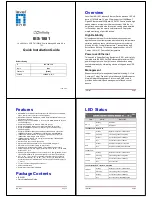
Installing Device
2.6 Connecting Power
2.6
Connecting Power
The RUGGEDCOM RS416F supports single or dual redundant high AC and/or low DC
power supplies.
The RUGGEDCOM RS416F can be equipped with either a screw-type or pluggable
terminal block, which provides power to both internal power modules. The screw-
type terminal block is installed using Phillips screws and compression plates, allowing
either bare wire connections or crimped terminal lugs. Use #6 size ring lugs for
secure, reliable connections under severe shock or vibration.
IMPORTANT
Each internal power module is labeled POWER 1 or POWER 2. Before connecting
power to the device, determine which module POWER 1 and POWER 2 are associated
with.
Note
• For maximum redundancy in a dual power supply configuration, use two
independent power sources.
• For 100-240 VAC rated equipment, an appropriately rated AC circuit breaker
must be installed.
• For 88-300 VDC rated equipment, an appropriately rated DC circuit breaker must
be installed.
• Use minimum #16 gage copper wiring when connecting terminal blocks.
• A circuit breaker is not required for 12, 24 or 48 VDC rated power supplies.
• It is recommended to provide a separate circuit breaker for each power supply
module.
• Equipment must be installed according to applicable local wiring codes and
standards.
2.6.1
Connecting AC or DC Power
To connect a single high AC, high DC or low DC power supply to the device, do the
following:
NOTICE
Electrical hazard – risk of damage to equipment
Before testing the dielectric strength (HIPOT) in the field, remove the metal jumper.
This metal jumper connects transient suppression circuitry to chassis ground and
must be removed in order to avoid damage to transient suppression circuitry during
testing.
16
RUGGEDCOM RS416F
Installation Manual, 04/2021, C79000-G8976-1354-04
















































